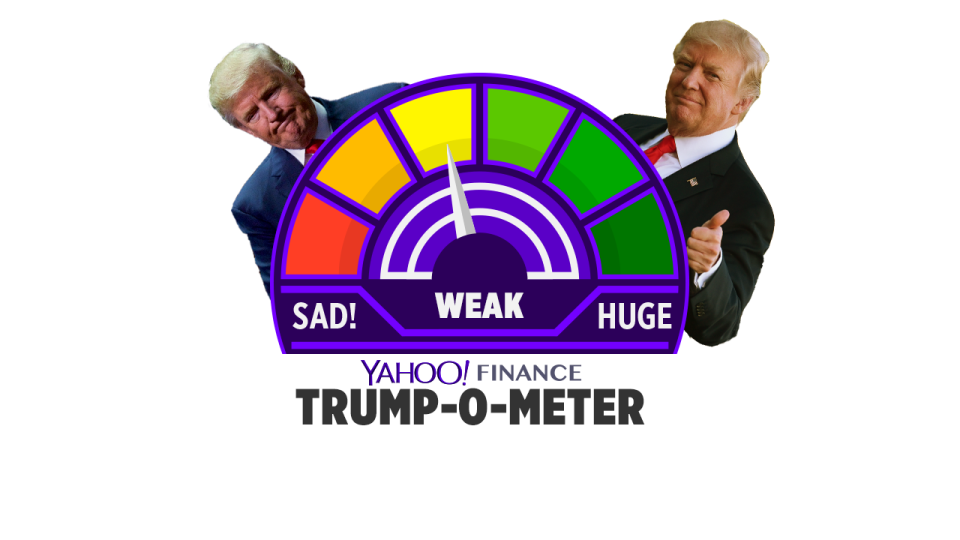This week in Trumponomics: Tariffs bite
Walmart says prices are heading higher. John Deere says trouble is brewing in the global economy. And economists say the typical American family will spend nearly $500 more than necessary this year.
This is President Trump’s trade war, which he famously described as “easy to win.” For now, however, everybody seems to be losing.
Trump escalated his trade dispute with China on May 10, when he raised tariffs on $200 billion worth of Chinese imports from 10% to 25%. Three days later, China retaliated with higher tariffs on U.S. imports. Each side is publicly sniping at the other, with no obvious plan to get negotiations back on track.
This isn’t the end of the world. The cost of the tariffs is small in the context of the $21 trillion U.S. economy. But the suddenly sour outlook on trade is depressing stocks, shaving estimates for GDP growth and making CEOs nervous about future investments. For these reasons, this week’s Trump-o-meter reads WEAK, our third-lowest rating.

The Trump-o-meter would be lower this week, except for a couple of compensating developments. The Trump administration is now set to lift tariffs on imported steel and aluminum from Mexico, with those countries lifting their own tariffs on a set of U.S. products in exchange. That brings the United States closer to ratifying an updated version of the North American Free Trade Agreement.
Trump also put off a plan to hit imported cars and car parts with 25% tariffs. Trump has six months to act on those tariffs, which are aimed mostly at Europe and Japan, rather than China. Imposing those tariffs would raise car prices, kill auto jobs and possibly induce a recession, so they’re a bad idea at any time. For now, we can worry about those later.
The impasse with China is problem enough. Trade talks that looked close to a deal just a few weeks ago have now deteriorated into a public standoff, with each side pouting in its respective corner. There are several possible outcomes. The two sides could still strike a deal that heads off further tariffs and removes some or all of the levies put in place during the last year. Markets would rejoice.
But it could just as easily go the other way. Trump could follow through on this threat to hit another $300 billion of Chinese imports with tariffs, which would promptly raise prices on many everyday products such as clothing, shoes, furniture, toys, bikes, tools, appliances and electronics. Oxford Economics says the new Trump tariffs are already costing the typical American family $490 per year. If Trump rolls out those additional tariffs, the toll will rise to $800 per year.

Is hurting China the whole point?
It’s also possible the current situation will become the new normal, with both sides having to live with higher tariffs on some but not all of the products traded between the two countries. Trump keeps saying the trade war hurts China more than the United States, with some companies beginning to move supply chains away from China, toward other low-cost countries such as Vietnam, India and Mexico. He’s probably right about that.
But is hurting China the sole point of Trump’s trade war? No. Trump’s original aim was to encourage more U.S. manufacturing by making imported products more expensive. That is barely happening, if at all, because it costs considerably more to build products in the U.S., and in some cases there simply aren’t enough workers or the right kinds of manufacturing facilities. Hurting China might be easier for Trump to measure, but it doesn’t do anything to help America.
Stocks are down around 2.4% since Trump announced his latest tariffs on May 5. Consumer confidence hit a 15-year high in April, but that was before the tariff escalation and economists don’t expect it to last. Trump’s approval rating, meanwhile, fell from 46% in April—the highest Gallup has measured—to a less-exalted 42% in May. Americans don’t like it when you raise their taxes, and they like it even less when you try to do it sneakily.
Confidential tip line: [email protected]. Encrypted communication available. Click here to get Rick’s stories by email.
Read more:
Meet the 2020 presidential candidates
Trump’s low threshold for stock-market pain
How Trump is blowing it with voters
Why Medicare for all is doomed
Joe Biden’s economic views need a major update
Rick Newman is the author of four books, including “Rebounders: How Winners Pivot from Setback to Success.” Follow him on Twitter: @rickjnewman
